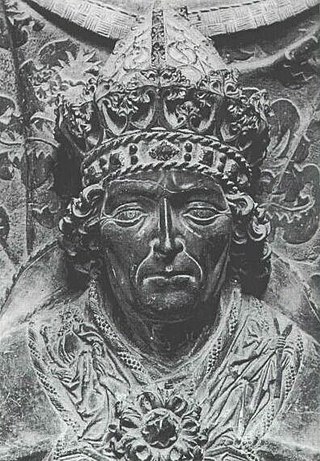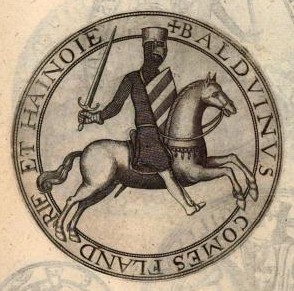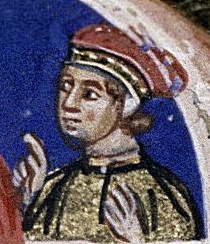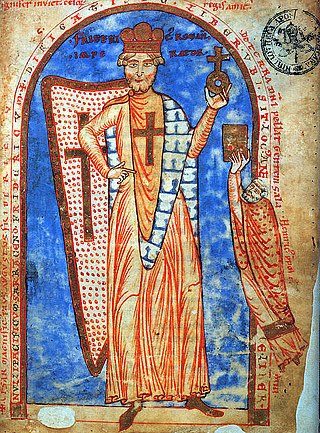
Louis IV, called the Bavarian, was King of the Romans from 1314, King of Italy from 1327, and Holy Roman Emperor from 1328 until his death in 1347.

Henry the Lion, also known as Henry III, Duke of Saxony and Henry XII, Duke of Bavaria, was a member of the Welf dynasty.

Frederick II, called the One-Eyed, was Duke of Swabia from 1105 until his death, the second from the Hohenstaufen dynasty. His younger brother Conrad was elected King of the Romans in 1138.

Baldwin V of Hainaut was count of Hainaut (1171–1195), margrave of Namur as Baldwin I (1189–1195) and count of Flanders as Baldwin VIII (1191–1195).

An Imperial State or Imperial Estate was a part of the Holy Roman Empire with representation and the right to vote in the Imperial Diet. Rulers of these Estates were able to exercise significant rights and privileges and were "immediate", meaning that the only authority above them was the Holy Roman Emperor. They were thus able to rule their territories with a considerable degree of autonomy.
Callixtus III was an antipope from September 1168 until his resignation in August 1178. He was the third antipope elected in opposition to Pope Alexander III during the latter's struggle with the Emperor Frederick Barbarossa.

In the Holy Roman Empire, a prince-abbot was the cleric who headed a princely abbey. The prince-abbot had a seat and an individual vote in the Imperial Diet alongside the prince-bishops. They ranked higher than the imperial abbots and imperial abbesses who although they were also immediate, held only two collective votes in the Diet.

Beatrice I was Countess of Burgundy from 1148 until her death, and was also Holy Roman Empress by marriage to Frederick Barbarossa. She was crowned empress by Antipope Paschal III in Rome on 1 August 1167, and as Queen of Burgundy at Vienne in August 1178.
Gislebertof Mons was a clergyman in the administration of the County of Hainaut and a chronicler whose Chronicon Hanoniense is an essential eyewitness source for events affecting his patron Baldwin V, Count of Hainaut.

Frederick, a member of the Přemyslid dynasty, was Duke of Bohemia from 1172 to 1173 and again from 1178 to his death.
Conrad of Wittelsbach was the Archbishop of Mainz and Archchancellor of Germany from 20 June 1161 to 1165 and again from 1183 to his death. He was also a cardinal of the Roman Catholic Church.
Philip I was Archbishop of Cologne and Archchancellor of Italy from 1167 to 1191.

The Curia Christi or Curia Dei was a diet or court day (Hoftag) of the Holy Roman Empire held in Mainz on 27 March 1188. It was so called because it was notionally under the presidency of Jesus Christ as king of kings. It was the occasion both for the public resolution of the conflict between Emperor Frederick Barbarossa and Archbishop Philip of Cologne and for the emperor's "taking of the cross", when he vowed to lead an army on the Third Crusade.

Henry VI, a member of the Hohenstaufen dynasty, was King of Germany from 1169 and Holy Roman Emperor from 1191 until his death. From 1194 he was also King of Sicily.

The County of Nidda (German: Grafschaft Nidda was a small county of the Holy Roman Empire centred on the city of Nidda in modern Wetteraukreis, Hesse. It was located on the northern edge of the Wetterau river valley and consisted of a relatively cohesive block of land held in fief from the Abbey of Fulda.

The Imperial Diet was the deliberative body of the Holy Roman Empire. It was not a legislative body in the contemporary sense; its members envisioned it more like a central forum where it was more important to negotiate than to decide.

The Diet of Regensburg of 1623 was a meeting of the Imperial States of the Holy Roman Empire convened by Holy Roman Emperor Ferdinand II. The meeting was not technically an imperial diet in the full sense, but a convention of princes or Deputationstag – a looser constitutional format giving the emperor greater leeway to take decisions without being bound by formal procedures. At it the Electorate of the Palatinate was transferred to Maximilian I of Bavaria. The meeting marked the high-water mark of imperial power during the Thirty Years' War.

Peter of Brixey was Bishop of Toul from 1167 to 1192, and a supporter of the Holy Roman Emperor Frederick Barbarossa in the late twelfth-century phase of the Investiture Controversy, one of the few bishops of Lorraine to do so.















